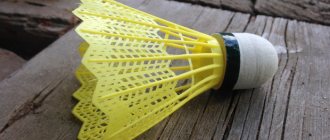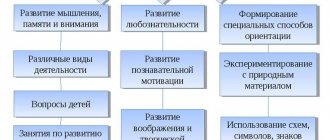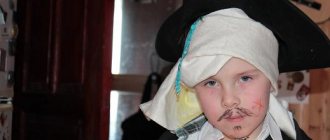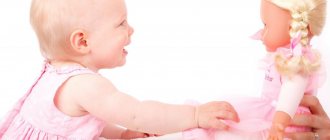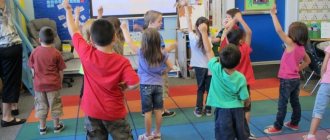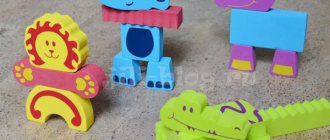Physical development of young children
Movement is the primary stimulus of a child's mind.
N.N. Amosov
Children are constantly on the move, exploring the world around them. Therefore, physical activity is as important for mental development as any game.
Movement is a natural need for a child, especially 2- and 3-year-olds.
In the third year of life, motor activity increases. The child masters the ability to walk freely, be good at climbing, be able to perform balance exercises, roll, and throw a ball.
He just needs noisy outdoor games, running, climbing, jumping. True, he still doesn’t do everything skillfully. Therefore, your main task is to teach your baby more advanced movements, develop his motor skills, and teach him more complex actions. This allows you to simultaneously form such personal qualities as intelligence, will, perseverance, and teach discipline. Proper physical education, begun from a very early age, develops in the child the habit of daily physical exercise, fosters a love of sports, and the habit of a healthy lifestyle. But this can only be achieved when the motto “Mom, Dad and I – all together” is the main one.
From 1 year to 3 years, the baby practically needs to develop all the basic types of movements. First of all, pay attention to your walking. It needs to be improved during the second and even third year of life.
His future health, good posture, and beautiful physique depend on how correctly he learns to walk [1, p. 19].
A child 2–3 years old should be able to run. Running can sometimes develop as quickly as walking, but he will not be able to run well any time soon.
Climbing and throwing are more difficult for a child, where many useful movements, especially of the hand and fingers, are simultaneously developed, coordination of movements, dexterity, and eye are improved.
It is necessary to teach systematically and persistently, based on the successes already achieved, coordinating classes with the age characteristics of the child.
Remember that the further successful development of the baby largely depends on proper physical education in this age period.
The first thing that needs to be clearly understood is that movements in young children develop mainly during play and independent motor activity.
If you do not restrain the child’s natural activity, but give him the opportunity to freely walk, run, climb a hill, go down it, throw a ball, snowballs, dig with a shovel, roll a car, sled, then his muscles will gradually become stronger, good coordination of movements will appear, he will will become dexterous.
At the same time, while giving the child a certain freedom, at the same time teach him, show and explain how best to perform this or that movement, so that the baby not only repeats you, but also comprehends it.
When raising a child physically, it is necessary to take into account his individual characteristics. If he is timid by nature and lacks self-confidence, he needs to be encouraged and praised for his successes. If he is balanced, has a calm character, even somewhat lethargic and inert, then involve him in active play, interest him in some new toy or inventing an exciting situation.
It is simply necessary to include some gymnastic exercises in the play of a 2-3 year old child. Therefore, all sets of physical exercises recommended for this age should be carried out with the baby in the form of a game. This can be done both at home and during a walk, playing with each exercise accordingly.
It is very important to create conditions at home for the child’s physical activity. It’s good if you can organize a “mini-stadium” at home. After all, a child already at 2.5 - 3 years old, and sometimes even earlier, will with interest climb on and off a ladder, swing on a swing, walk on a flat and inclined board, etc.
Each age has its own physical education.
Don't force your baby to do any exercise if he doesn't want to.
Morning exercises can and should be carried out systematically from the age of two, as it develops motor skills, strengthens muscles, creates correct posture, trains and strengthens the activity of all organs and systems.
Morning exercises prepare the child’s body for the stress that he will experience during the day. Well, if you do it together with him, the whole family, then it has great educational significance.
The playful form of gymnastics makes children want to participate in it. It is fun and promotes the development of independence; coordination and rhythm of movements [4, p. 15].
Choose rhythmic music for gymnastics. Encourage your child more, try to create a good mood in him. And most importantly, deal with it yourself.
Do not think that physical education can be limited only to a set of exercises or morning exercises. Take advantage of every opportunity, every opportunity!
For example, summer walks. Try to spend more time with your baby in the park, in the garden, and go out of town. If you live in a summer house in the summer, do not limit yourself to the boundaries of your plot, go out into the field, into the forest, or onto the river. During such walks, the baby gradually gets used to controlling his movements in various environments, finding himself in natural conditions.
Plan a walking route in advance so you can walk a certain distance with your baby. This builds up his stamina.
You can play a little (catch up, hide and seek, etc.) and, having rested again, set off on the way back.
Make sure that your baby can move actively and not freeze when going for a walk in the winter. You can make well-compacted slides of different heights and widths with ladders, a spiral path, etc. For a walk, give your child a shovel, a sled so he can dig and transport snow, and also a broom to sweep the paths.
Try to organize an outdoor game with a small group of children or some kind of joint activity with one or two children (baking Easter cakes, building something, transporting goods, etc.). Your child will only benefit from this, especially if he does not attend preschool. While playing together, the child receives his first lessons in social behavior and makes friends.
Remember: a young child should not jump from great heights or lift weights.
From the age of 1.5 years, a child can slide down small, gentle slides on a sled, and then climb up independently. Kids can push each other on sleds along smooth paths. All this develops strength, agility, and determination. From the age of 2.5 years he can already be taught to ski. But at the same time, it is important to observe the necessary gradualism and consistency so as not to discourage you from this activity. First, the baby skis without poles, maybe even with support from one hand, and then with poles. At the age of 3, some children can already ski quite well and even slide down small hills. These exercises develop all major muscle groups, develop endurance, courage, and promote good coordination of movements. From 1.5-2 years old, a child can ride a tricycle. You just need to make sure that the size of the bike matches the child’s height and that he doesn’t get overtired.
The main thing is to ensure harmonious physical development: improve skills in the main types of movements, cultivate beauty, grace, expressiveness of movements, and form correct posture.
Form the need for daily physical activity. Develop initiative, independence and creativity in motor activity, the ability for self-control, self-esteem when performing movements.
Develop interest in participation in outdoor and sports games and physical exercises, activity in independent motor activities [3].
The physical development of a child in the first years of life plays a dominant role; it predetermines the child’s future life. First of all, it is responsible for the health and intellectual development of the baby. A well-developed mind is a consequence of harmonious physical development in childhood.
By the age of two, the child has already mastered walking quite well, and is now fascinated by running and jumping. He can run quickly, stop abruptly if necessary, and pick something up off the floor. At this time, it is worth paying attention to fine motor skills, which perfectly train the brain. There are various games for this: sandbox, plasticine drawing, mosaic, simple puzzles, finger painting, applique.
At three years of age, physical development slows down and gives way to mental development. Movements at this age are already more refined and purposeful. Children can work synchronously with their arms and legs. At this time, the child can independently climb the stairs up the gymnastics wall, crawl under an obstacle, and jump on two legs.
When developing a child physically, the most important thing is to show respect for the will, desires and mood of the child. From the first days of life, it is important to learn to understand the child’s mood, to recognize what he likes and what upsets him. All children grow and develop at their own pace. It’s okay if the child does not master all of the above skills; progress and improvement of abilities as the baby grows and develops is important.
We, adults, are responsible for how perfect and complete the child’s motor system will be in the future.
Literature:
- Litvinova M.F. Physical education classes with young children: the third year of life: practical work. allowance. M.: Iris-press, 2005. 288 p. (Preschool education and development).
- Laizane S.Ya. Physical education for kids: Book. For the teacher of children. garden M.: Education, 1987.160 p.
- From birth to school: the basic educational program of preschool education / ed. NOT. Veraksy, T.S. Komarova, M.A. Vasilyeva. M.: Mozaika-Sintez, 2016. 352 p.
- Osokina T.I. Physical education in kindergarten. M.: Education, 1986. 304 p.
Common types of physical education for children
- Physical education and health activities
(massage, gymnastics, exercises, physical education, warm-ups). Daily classes conducted at home or as part of the educational process in educational institutions; - Physical education lessons
. Conducted on the basis of preschool or school educational institutions, at home, with a certain frequency; - Sports sections, clubs, schools.
Specialized classes are conducted by professional trainers; - Yard games and competitions.
Sudden or periodic outdoor activities using certain rules and setting tasks for the child. It is optimal to involve his peers in them. - Sports holidays.
A complex, but educationally and physically useful option for the development of a child. Perhaps as attending an organized event or preparing your own; - Joint sports recreation
: hiking, cycling, etc.
The indicated types of physical education are the most recommended options by teachers and doctors, which can be used both separately and together. The choice of a specific type should be made based on the age and general physical development of the child.
Physical education and health activities (exercises, physical education minutes, warm-ups)
It is recommended to introduce physical education and health activities into the daily educational process from the age of 1, not taking into account the forms used for infants (massage, fitball, etc.)
First of all, the child is introduced to exercises done in the morning before meals. Its duration for preschoolers does not exceed 10 minutes, for schoolchildren - up to 20 minutes. As part of the exercise, the main goal is to warm up all joints and activate the work of all cells of the body. On weekdays, you can limit yourself to a small set of 5 minutes, and on weekends you can do a full set of exercises.
From 5-6 years of age, when using teaching methods that require the child to be in a static position (sitting at a table) for some time, it is advisable to introduce new forms of physical education and health activities - physical education and warm-ups. They are carried out to prevent the development of scoliosis and visual impairment. Carrying out time up to 5 minutes. The form can be chosen based on the age of the child.
Daily gymnastics performed during the daytime has an excellent effect on the development of physical skills. It can be introduced into a child’s life from the age of 3, but the most suitable age is 5-6 years. As part of gymnastics, you can offer to master exercises that improve flexibility, endurance, and stamina.
Physical education lessons
Physical education lessons for children of different ages should be structured in accordance with their physical and mental characteristics. It is advisable to introduce this form of physical education from the age of 3.
For children 3-4 years old, the maximum duration of a lesson should not exceed 15 minutes and should be based on frequent changes of exercises (no more than 3 repetitions of one exercise).
For children 4-5 years old, a physical education lesson can last up to 20 minutes. It is possible to include more complex elements accessible to the child.
From 5 to 7 years old, physical education lessons last 20-30 minutes and are built on the basis of improving qualities such as speed, endurance, and flexibility.
From 7 to 9 years old, the duration of the lesson is up to 35 minutes. The main direction of development is flexibility, endurance, speed. You should carefully monitor the body's reaction to stress. At this age, it is possible to intensify growth, and against this background, a slight decrease in activity may occur (internal organs grow a little slower than the bone and muscle apparatus);
From 9 to 17 years old, a physical education lesson can last from 45 to 60 minutes and include active games, gradually more complex elements, and complex techniques.
Conducting a lesson requires compliance with some rules:
- The child must be completely healthy and in good spirits;
- After the last meal, at least 30 minutes should pass, optimally about an hour;
- Physical education lessons must be planned and conducted once every 2-3 days;
- It is possible to conduct a physical education lesson with elements used during exercise, but the physical education lesson does not replace it, but complements it.
- The principle of the lesson is built according to the classical scheme: warm-up, the main block of exercises and games, a relaxing set of exercises, self-massage, calm walking.
Sport sections
Attending sports sections, clubs and schools is the 2nd stage of a child’s physical development, introduced into the educational process after he reaches a certain level of physical fitness. Workload restrictions for children have been introduced at the state level. Thus, children under 6-7 years old, when visiting sports sections, perform exercises aimed at developing general skills and developing an understanding of the need to maintain a healthy lifestyle.
After the child reaches the age of 6-7 years, physical activity increases depending on the level of training. Thus, professional classes are available to children who have fulfilled the established standards without significant energy expenditure.
The purpose of the section is to improve general physical skills and achieve maximum development in the chosen direction. It is important to choose the right sports section for your child.
Yard games
Yard games, as a form of physical development, are introduced at 3-4 years of age with the involvement of the child’s peers. The main goal is to stimulate the development of qualities such as speed, agility, and endurance. In a playful form, children are invited to play according to certain rules, while striving to achieve a designated goal: catch up, overtake, come first, perform better.
This form of physical education is the most attractive for children, providing them with the most important elements: communication, movement, development.
Sports holidays
Organizing sports events is one of the most difficult, but educationally most productive forms of child physical development. By watching adults prepare, conduct and organize sports competitions, the child develops mental abilities, while learning the need to be active. Participation and the desire to win allow the baby to compete at the top level of his capabilities.
Hiking, walking, joint active recreation
Joint recreation using forms of physical development is an excellent way not only to improve physical skills, but also to improve family relationships and emphasize the importance of a healthy lifestyle.
The type of activity should be selected based on the age and physical fitness of the child.
It is recommended to start using joint hikes and walks by gradually increasing the distance covered by the child on foot during a daytime walk. This could be a visit to a store located at a distance, giving up a vehicle when visiting a clinic, or constantly walking to a kindergarten or club.
After confidently mastering a long walk, adults can organize a hike with rest to achieve the designated goal. To make the event comfortable for all participants, possible stops with interesting rest options and snacks should be provided.
From 6-7 years of age, cycling can be used if the child confidently uses this type of transport. The choice of route must be made carefully, excluding dangerous areas or organizing their passage with maximum safety. For example, if a section of the road runs along the highway, it would be advisable to walk it.
Active family recreation is one of the ways to develop a child physically
